Heavy Loads for All Roads
Chances are you’ve known what a dump truck is since you were a child. Tonka’s dump truck toy is still among the favorite of little boys and girls to play with in sand boxes across the United States. The boxy truck cab and large tipping container has to be one of the most recognizable units on a jobsite — it’s also one of the most versatile.
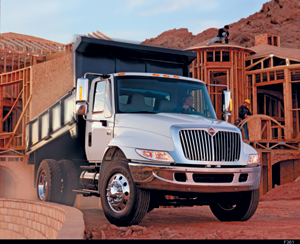
Dump truck chassis are typically in the medium-duty range from Class 4 to Class 7 and also include the commercial-grade Class 3 trucks available from such manufacturers as Chrysler (Ram Trucks), Ford, Navistar and Freightliner, to name a few. There are a wide variety of dump bed upfitters, such as DuraClass, Beau-Roc, Iroquois and Caseco, with different bed and hoist options available.
When buying a dump truck, you should consider the truck chassis cab make and model and the dump bed upfitter equally, says Chris Borczon, senior chassis engineer for Chrysler’s Commercial Vehicle Team, which manufactures the Ram Trucks lineup of the 3500, 4500 and 5500 chassis cabs. The applications will help determine the truck size and engine power to suit your hauling needs, as well as the size, shape and hoist of a dump body.
A complete truck package can incorporate the chassis, dump body, hoist and accessories, says Jeri Retzlaff, marketing manager for Truck Bodies & Equipment International Inc. (TBEI), which manufactures the DuraClass line of dump bodies.
“When your dealer understands the application of the truck, he or she can best help identify which items will help your business,” she says. “For example, tarp rules have become common, so including that in your initial purchase decision will ensure that you have a body with the right tarp fit and body access.”
While it might be easy to choose which truck manufacturer you go with, dump bed upfitters can be a little more difficult to choose because there are so many manufacturers in the market. Retzlaff and Borczon suggest choosing a hoist manufacturer that is rated by the National Truck Equipment Association (NTEA), which will help ensure that the unit has the lifting capacity needed for a specific application.
“We [DuraClass] also recommend that you purchase a dump body and hoist from the same manufacturer to ensure the best fit,” Retzlaff adds.
Amassing the Chassis
Buying a dump truck consists of two primary pieces — the chassis and the dump body. There are plenty of options to choose from when determining the right frame for a dump body, from the commercial-grade Class 3 chassis cabs up to the medium-duty Class 7 chassis. Determining which size you need will depend on how you want to use the dump truck.
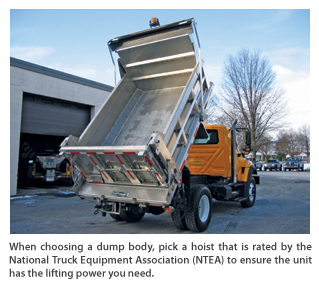
Chassis cabs are available in both regular and crew cabs, if you have to consider hauling people along with the load.
Another consideration is whether operating the dump truck will require a commercial driver license (CDL). As long as the gross vehicle weight rating (GVWR) or gross combined weight (GCW) is less than 26,000 lbs, Borczon says, you do not need a CDL.
That means just about any dump truck in the Class 3 to Class 5 range will be operable without a CDL. Class 6 dump trucks are on the cusp of needing a CDL, as those units range up to 26,000 lbs GVWR.
The GVWR of each truck classification are:
- Class 3: 10,001 to 14,000 lbs
- Class 4: 14,001 to 16,000 lbs
- Class 5: 16,001 to 19,500 lbs
- Class 6: 19,501 to 26,000 lbs
- Class 7: 26,001 to 33,000 lbs
These chassis cabs cost between $36,000 for Class 3 units and upward of $75,000 for Class 7 vehicles, depending on the make, model and options — and that ticket price does not include the dump body.
While the chassis cab is an important consideration in getting the right dump truck, don’t forget to factor in the dump body during the truck purchase. “Both should be discussed and purchased at the same time,” Borczon says. “The worst thing that could happen is a mismatch of truck and dump body.”
Talking to a dealer is the best method in getting what you want and, more importantly, what you need.
“You should have a discussion with an experienced truck or dump body salesman,” Borczon suggests. “It is critical that you get a truck capable of carrying the heavy loads frequently hauled in a dump body.”
To Wed Truck to Dump Bed
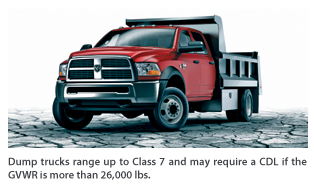
“Understand the GVW of the truck, weight of the equipment you are considering and the weight of the material you will carry,” Retzlaff says. “Allow for maximum scenarios and ensure that you do not overload the GVW capacity. Weights of various materials can be found online or from your local distributor.”
Next, consider how the dump truck will be used. The types of applications — from hauling construction materials to salt for clearing snow — will determine the features needed. Work with the upfitter to get the right product for your needs.
“Although snow plow trucks will ultimately be used in the summer season as well, the focus may be on the winter usage,” Retzlaff says. “Considering alternative materials to resist corrosion from salt may be a consideration. Stainless steel has become common for municipal applications. All-season bodies, such as the DuraClass Sidewinder, offer versatility to be able to move from a salt and sand spreading application to carrying dirt without the time loss of having to remove a salt spreader.
“Bodies that will be primarily used in dirt hauling applications will be focused more on capacity, hoist cycle time and weight. Customers should consider high-tensile steels, which will weigh less, providing additional payload. Hoists, which require a doghouse, also take both additional body capacity, as well as cause materials to stick to the doghouse, which reduces payload. Choosing an underbody hoist can provide that additional payload capacity.”
Dump bodies are available in all manner of styles, from light- to heavy-duty, shallow or deep walled, coated or stainless steel and aluminum options and ranging in length from 8 1/2 to 22 ft. Depending on the options and styles, these dump bodies start at around $3,850 for the most basic units to about $28,000 for a full-bore, heavy-duty rig.
Also, don’t forget to consider the hoist needed to lift the dump bed. Hoists vary from high-pressure telescopic styles to scissor-style hydraulic options. The NTEA offers a handy guide to hydraulic dump body hoists on its Web site in the Technical Resources section (www.ntea.com/Hoist/DumpBody.aspx).
Choosing where to buy a dump truck is an important consideration. Both location and reputation are important factors.
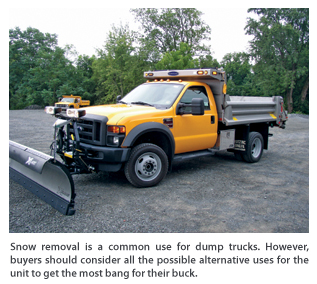
Once all these variables are considered, the wait begins. Many upfitters have units in stock for customers who need a quick turnaround, ranging from same-day to two-week delivery. Customers who require specific features may have to wait three to four weeks for their made-to-order body.
The recession has had a profound effect on the truck industry, as it closely correlates to the housing industry and as contractors and government entities have had to cut back on costs to stay afloat. However, truck manufacturers are now poised to help businesses capitalize on the recovering economy.
“The past few years have been a challenge for all manufacturers in the truck industry,” Retzlaff says. “The investment a customer makes in each truck is important to everyone involved; allow your manufacturer to build the right features for your specific needs that will truly help your business grow.”
Bradley Kramer is a contributing editor for Compact Equipment, based in Peninsula, Ohio.
Navistar Unleashes Enhancements to its Severe Service Trucks Lineup
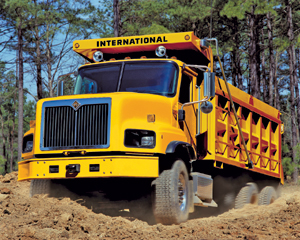
From driver-comfort features to new axle configurations, these enhancements will provide customers with the reliability and performance they’ve come to expect from the industry-leading lineup of International brand severe service trucks.
Now, the International WorkStar models will include these features:
- Heavy-duty diesel WorkStar models (7600 and 7700) are combined into one model with two variations, the 7600 SBA (46-in. set-back axle) and 7600 SFA (30-in. set-forward axle). Both models will feature a new 113-in. BBC (bumper to the back-of-cab) for increased cooling efficiency.
- A crew cab configuration is now available in heavy-duty diesel models with front axle ratings up to 18,000 lbs for select applications.
- All-wheel drive (AWD) is now available up to 18,000 lbs on front axles on mid-range diesel configurations.
- Steerable 20,000-lb lift axles are now available direct from the factory.
- Aluminum fuel tanks improve corrosion resistance and reduce weight.
- HVAC system has been redesigned to improve in-cab comfort and system reliability.
For International PayStar models:
- Electronic stability control is available on all PayStar models.
- 8,000-, 13,200- and 20,000-lb lift axles are available direct from the factory.
- New 10 1/4- by 3/8-in. frame rails are now standard equipment on the PayStar 5900 SBA. The
- 10 1/4-in. frame rail provides customers with a strong vocational frame in applications where vehicle weight is important.
- MaxxForce 11 and MaxxForce 13 diesel engines will be available in the PayStar in the months ahead.
- MaxxForce 15 will be available in late 2010.
The foundation of Navistar’s customer-focused approach is built on its lineup of the company’s hassle-free 2010 MaxxForce Advanced exhaust gas recirculation (EGR) engines. WorkStar and PayStar with MaxxForce Advanced EGR engines are the only severe service trucks in the industry that won’t require the additional weight and packaging challenges that come with selective catalytic reduction (SCR) systems. The MaxxForce Advanced EGR engines also let drivers drive without worrying about finding or adding urea to their vehicles.


Comments are closed here.